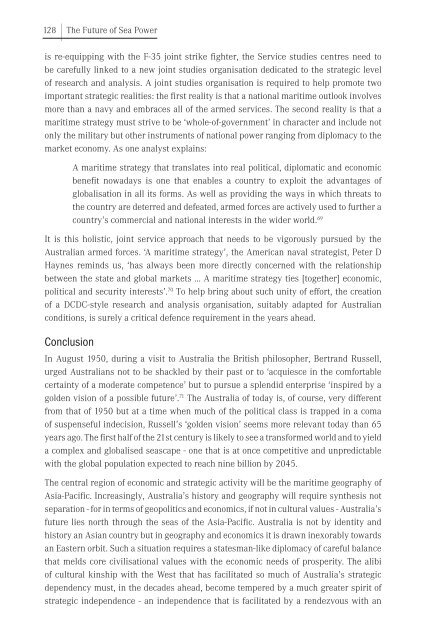THE FUTURE OF SEA POWER
SPC2015_Proceedings
SPC2015_Proceedings
Create successful ePaper yourself
Turn your PDF publications into a flip-book with our unique Google optimized e-Paper software.
128 |<br />
The Future of Sea Power<br />
is re-equipping with the F-35 joint strike fighter, the Service studies centres need to<br />
be carefully linked to a new joint studies organisation dedicated to the strategic level<br />
of research and analysis. A joint studies organisation is required to help promote two<br />
important strategic realities: the first reality is that a national maritime outlook involves<br />
more than a navy and embraces all of the armed services. The second reality is that a<br />
maritime strategy must strive to be ‘whole-of-government’ in character and include not<br />
only the military but other instruments of national power ranging from diplomacy to the<br />
market economy. As one analyst explains:<br />
A maritime strategy that translates into real political, diplomatic and economic<br />
benefit nowadays is one that enables a country to exploit the advantages of<br />
globalisation in all its forms. As well as providing the ways in which threats to<br />
the country are deterred and defeated, armed forces are actively used to further a<br />
country’s commercial and national interests in the wider world. 69<br />
It is this holistic, joint service approach that needs to be vigorously pursued by the<br />
Australian armed forces. ‘A maritime strategy’, the American naval strategist, Peter D<br />
Haynes reminds us, ‘has always been more directly concerned with the relationship<br />
between the state and global markets ... A maritime strategy ties [together] economic,<br />
political and security interests’. 70 To help bring about such unity of effort, the creation<br />
of a DCDC-style research and analysis organisation, suitably adapted for Australian<br />
conditions, is surely a critical defence requirement in the years ahead.<br />
Conclusion<br />
In August 1950, during a visit to Australia the British philosopher, Bertrand Russell,<br />
urged Australians not to be shackled by their past or to ‘acquiesce in the comfortable<br />
certainty of a moderate competence’ but to pursue a splendid enterprise ‘inspired by a<br />
golden vision of a possible future’. 71 The Australia of today is, of course, very different<br />
from that of 1950 but at a time when much of the political class is trapped in a coma<br />
of suspenseful indecision, Russell’s ‘golden vision’ seems more relevant today than 65<br />
years ago. The first half of the 21st century is likely to see a transformed world and to yield<br />
a complex and globalised seascape - one that is at once competitive and unpredictable<br />
with the global population expected to reach nine billion by 2045.<br />
The central region of economic and strategic activity will be the maritime geography of<br />
Asia-Pacific. Increasingly, Australia’s history and geography will require synthesis not<br />
separation - for in terms of geopolitics and economics, if not in cultural values - Australia’s<br />
future lies north through the seas of the Asia-Pacific. Australia is not by identity and<br />
history an Asian country but in geography and economics it is drawn inexorably towards<br />
an Eastern orbit. Such a situation requires a statesman-like diplomacy of careful balance<br />
that melds core civilisational values with the economic needs of prosperity. The alibi<br />
of cultural kinship with the West that has facilitated so much of Australia’s strategic<br />
dependency must, in the decades ahead, become tempered by a much greater spirit of<br />
strategic independence - an independence that is facilitated by a rendezvous with an


